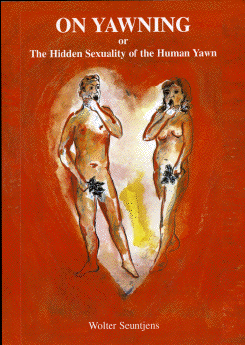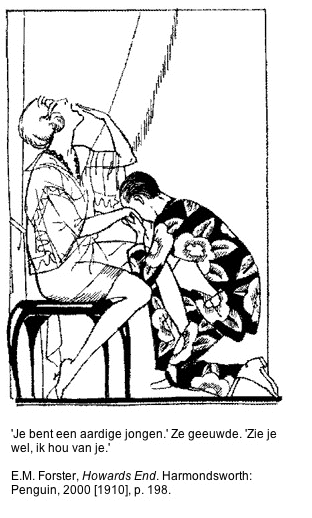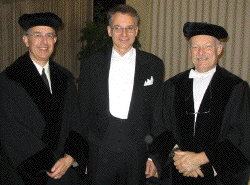- Annals
of Improbable Research
(AIR) and
pdf
-
 -
- On
Yawning or The Hidden Sexuality of the Human
Yawn
-
- In science yawning has
not received its due attention. In this
investigation. Wolter
Seuntjens
gives a systematic-encyclopaedic overview of all
available knowledge about the yawn. The fields
from which he derives his data are semantics and
etymology, sociology, psychology, the medical
sciences (anatomy, physiology, pathology, and
pharmacology), and the arts (literature, film,
visual-arts).
-
- Then, Wolter Seuntjens
associates a number of these data in order to
test the hypothesis : yawning has an erotic
side, yawning has a sexual aspect.
-
- As the total amount of
circumstantial evidence surpasses a critical
mass, he can, for the present moment and until
future refutation, assume this hypothesis to be
correct. Furthermore, he provides two
predictions about prospective scientific
research that will enable a more direct testing
of his hypothesis.
-
- Finally, Wolter Seuntjens
enumerates 22 theses. The two foremost
conclusions of this investigation are
:
- the yawn is, contrary to
common-sense ideas, far from trivial; yawning is
an extremely complex and significant behaviour.
-
- The yawn, and this
clashes even more with common sense notions,
appears to have an erotic side, a sexual
aspect.
-
- Stretching
and yawning witht Yeats and
Pound. Clark
DR
- Recapitulation
pages 364-367
-
- The mass of data that we
presented in the encyclopaedic overview makes
one thing clear: there is no good explanation
for yawning.
-
- As regards physiology
: the hypoxia and hypercapnia theories -
these long-untested theories that also figure
prominently in common-sense notions - were
conclusively refuted by Robert Provine and his
collaborators (Provine, Tate, and Geldmacher
1987). The now popular theory that yawning leads
to wakefulness ('arousal defense reflex')
(Askenasy 1989) is not without its problems
(Laing and Ogilvie 1988; Dourish and Cooper
1990: 103). Formulated more ambiguously as "an
important function of yawning [might be]
to modify levels of cortical arousal"
(Baenninger 1997: 205) this theory clarifies
little or nothing, especially where the current
deus ex machina is invoked:
-
- "Maintaining or attaining
a particular level of arousal is an important
matter in the life of most vertebrates, and
yawning, to the extent that it serves as a means
for doing so, should be seen as an important
part of adaptive behavior."
-
- In the paragraphs on
pathology and pharmacology we found so many
different illnesses and disorders that are
associated with increased yawning that for the
moment it is impossible to extract a common
factor. The same goes for the very many chemical
substances that induce yawning (Crenshaw and
Goldberg 1996: 415; Argiolas and Melis 1998:
12). What this common pharmacological factor, if
there is one, constitutes, remains
unclear.
-
- In the chapter on the
psychology of yawning we discussed various
subthemes of which the most concrete are:
contagiousness, non-verbal behaviour, and
conditionability. Neither of these subthemes has
been completely clarified. Psychologically, too,
the yawn is still very much an unsolved
riddle.
-
- In the chapter on the
sociology of the yawn we found that the yawn
is (quasi-)universally taboo. The reason why
this is so remains shrouded in mystery: the
various rationales given - superstitious,
hygienic, aesthetic, psychological - are all
implausible. The ethological rationale (bared
teeth) may turn out to provide the best
explanation for the taboo of
yawning.
-
- As a preliminary
conclusion we may therefore state that Reber's
Law applies perfectly to the hitherto considered
trivial behaviour of yawning: the closer the
yawn is examined, the more complex it is seen to
be (Reber 1985: 618). In fact, we have really no
idea what causes yawning and what purpose
yawning serves or what mechanisms are
responsible for yawning and even what the
essential anatomical constituents of yawning
are. In the age in which the human genome has
been deciphered and space travel has become
almost trite this verdict may sound as an
affront. What, however, is worse than admitting
ignorance? It is the hubris that some scientists
show by trying to force the yawn into one
general explanatory formula. They fall victim to
what Aldous Huxley termed 'the Original Sin of
the Intellect, the urge to oversimplification.'
(Huxley 2001).
-
- Yet, in the light of the
hypothesis (H1) it becomes clear that in the
data that we gathered there is at least one
recurrent theme: eroticism-sexuality. There is
indeed more than a hint of an erotic-sexual
aspect in yawning.
-
- We found that both the
'yawn' and the 'stretch of the SYS are
semantically and etymologically associated with
'desire' and 'longing for' (Muller and Thiel
1947: 768). In several proverbs and sayings
yawning - and especially contagious yawning - is
interpreted as a clue of something more than
just sympathy, as a sign of being in love
(Schlossar 1891: 402; DLI 1977, vol. 17: 75;
Hand 1981, no. 12964; Beyer 1985: 187; Hiller
1986: 69). Yawning was both linked with
acedia-boredom and with luxuria (lechery) and
passion. As a non-verbal behaviour the yawn was
found to figure - be it consciously or
unconsciously - in the courtship process (Howell
1659; Féré 1905; Kars 1969; Givens
1978, 1984; Moor, de 1995). That this is not a
purely recent or western phenomenon was
illustrated by passages from ancient Indian
literature (Schmidt 1922; Vatsyayana 1965;
Biharilal 1990; Kesavadasa 1993). Not
surprisingly perhaps, the few psychoanalysts who
did mention the yawn interpreted it as a latent
sexual signal (Meerloo 1955: 65; Marcus 1973;
Felstein 1976).
-

- Ethological
studies in primates found a clear
relationship between yawn-frequency and
hierarchical status (Bielert 1978; Hadidian
1980; Deputte 1994) and between yawn-frequency
and the serum level of testosterone (Chambers
and Phoenix 1981). In the paragraph on anatomy
and physiology we found that Chouard and
Bigot-Massoni (1990: 146, 152) described the
feeling that accompanies the acme of yawning as
a 'mini orgasm'. Moreover, the same authors
concluded: "Retenons surtout pour conclure son
intime et inconsciente relation avec la vie
sexuelle, […]." (Let us remember in
conclusion its intimate and unconscious relation
with sexual life, […].) (Chouard
and Bigot-Massoni 1990: 152). In the paragraph
on pathology we discovered that yawning and
spontaneous ejaculation were observed
concomitantly in terminal rabies (Beek 1969). In
the paragraph on pharmacology we found a link
between yawning and spontaneous orgasm in
withdrawal from heroine addiction (Parr 1967;
O'Brien 1996).
-
- Likewise, yawning and
sexual response (SR) were associated as clinical
side effects of several antidepressant drugs. In
one publication an undeniable causal relation
was reported: both spontaneous and intentional
yawning provoked instantaneous
ejaculation-orgasm (McLean, Forsythe, and Kapkin
1983). In experiments with animals many more
substances were seen to induce, sometimes
simultaneously, both stretch-yawn syndrome (SYS)
and SR. We found that in humans apomorphine
induces both SYS and SR (Lal et al. 1987a,
1987b, 1989).
- In the chapter on yawning
and the arts, we discussed, in a somewhat more
conjectural manner, the conspicuously erotic
sigh and the equally erotic posture X. I argued
for the interpretation of the sigh and posture X
as the auditory and visual proxies of the
SYS.
-
- It is because of the
critical mass of circumstantial evidence that we
accumulated in the foregoing chapters that all
these data, passages, and quotations take on an
ambivalent or double meaning. Nowhere is that
clearer than in the use of the words 'yawning'
and 'stretching' in the poetry of W. B. Yeats,
as for instance in:
-
- O cruel Death give three
things back,
- [...]
- Three dear things that
women know,
- [...]
- The third thing that I
think of yet,
- [...]
- Is that morning when I
met
- Face to face my rightful
man
- And did after stretch and
yawn.
-
- And what to think of the
following passage taken from 'The Prime of Miss
Jean Brodie' by Muriel Spark in which the pupils
Jenny and Sandy discuss their teacher's love
life:
-
- "For this reason she was
more reticent than Jenny about the details of
the imagined love affair. Jenny whispered, 'They
go to bed. Then he puts out the light. Then
their toes touch. And then Miss Brodie…
Miss Brodie…' She broke into
giggles."
-
- 'Miss Brodie yawns,' said
Sandy in order to restore decency, now that she
suspected it was all true.
-
- The yawn in this passage
serves as an anti-climax but is therefore also
ambiguous and thus comical. Equally ambiguous is
the passage from Thomas Hardy's novel 'Tess'.
Angel Clare watches Tess while she yawns and
stretches and is overwhelmed by love and
desire.
-
- "She had not heard him
enter, and hardly realized his presence there.
She was yawning, and he saw the red interior of
her mouth as if it had been a snake's. She had
stretched one arm so high above her coiled-up
cable of hair that he could see its satin
delicacy above the sunburn; her face was flushed
with sleep, and her eyelids hung heavy over the
pupils. The brim-fullness of her nature breathed
from her. It was a moment when a woman's soul is
more incarnate than at any other time; when the
most spiritual beauty bespeaks itself flesh; and
sex takes the outside place in the
representation."
-
 -
- Yawning
: comparative study of knowledge and
beliefs, popular
and medical
- The
nonverbal basis of attraction: flirtation,
courtship and seduction. Givens D
- Yawning
Mannerism of speech and gestures in evryday
life Feldman S 1959
|








